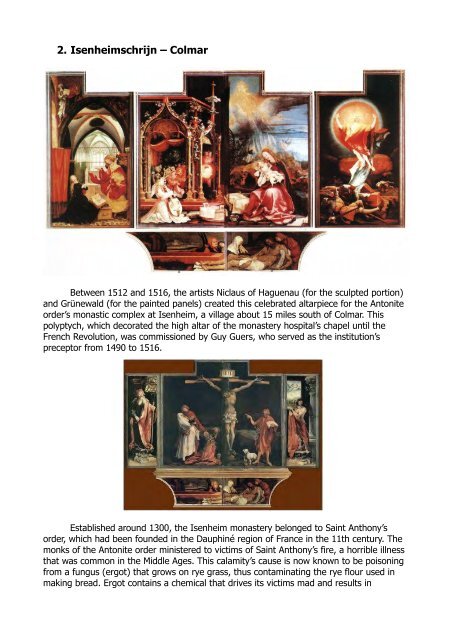Het Huis Stoclet in Brussel - Academie voor Beeldende Kunsten Aalst
Het Huis Stoclet in Brussel - Academie voor Beeldende Kunsten Aalst
Het Huis Stoclet in Brussel - Academie voor Beeldende Kunsten Aalst
You also want an ePaper? Increase the reach of your titles
YUMPU automatically turns print PDFs into web optimized ePapers that Google loves.
2. Isenheimschrijn – Colmar<br />
Between 1512 and 1516, the artists Niclaus of Haguenau (for the sculpted portion)<br />
and Grünewald (for the pa<strong>in</strong>ted panels) created this celebrated altarpiece for the Antonite<br />
order’s monastic complex at Isenheim, a village about 15 miles south of Colmar. This<br />
polyptych, which decorated the high altar of the monastery hospital’s chapel until the<br />
French Revolution, was commissioned by Guy Guers, who served as the <strong>in</strong>stitution’s<br />
preceptor from 1490 to 1516.<br />
Established around 1300, the Isenheim monastery belonged to Sa<strong>in</strong>t Anthony’s<br />
order, which had been founded <strong>in</strong> the Dauph<strong>in</strong>é region of France <strong>in</strong> the 11th century. The<br />
monks of the Antonite order m<strong>in</strong>istered to victims of Sa<strong>in</strong>t Anthony’s fire, a horrible illness<br />
that was common <strong>in</strong> the Middle Ages. This calamity’s cause is now known to be poison<strong>in</strong>g<br />
from a fungus (ergot) that grows on rye grass, thus contam<strong>in</strong>at<strong>in</strong>g the rye flour used <strong>in</strong><br />
mak<strong>in</strong>g bread. Ergot conta<strong>in</strong>s a chemical that drives its victims mad and results <strong>in</strong>



